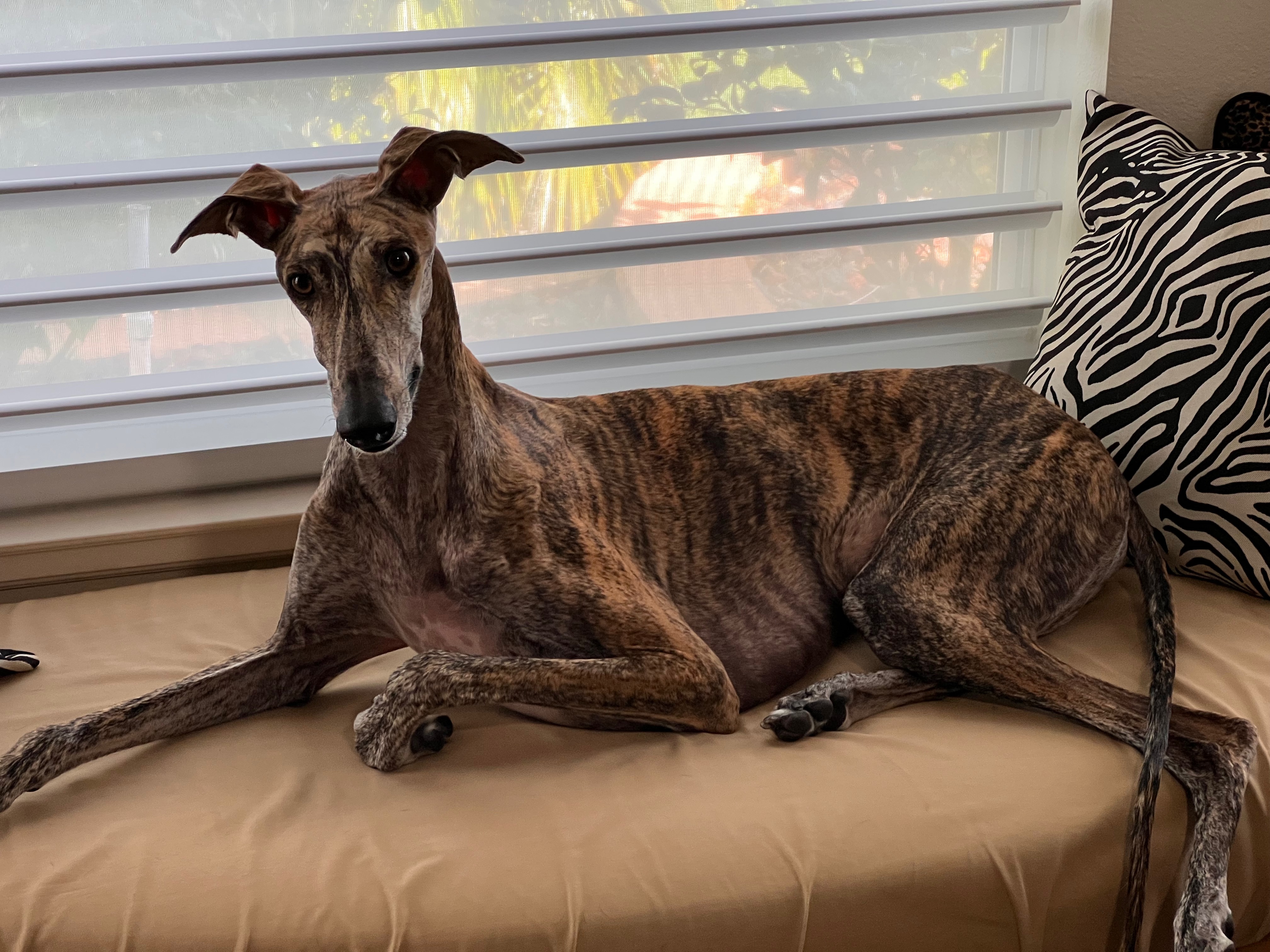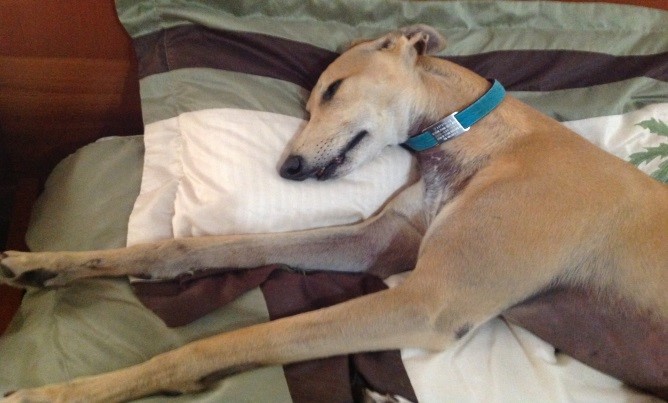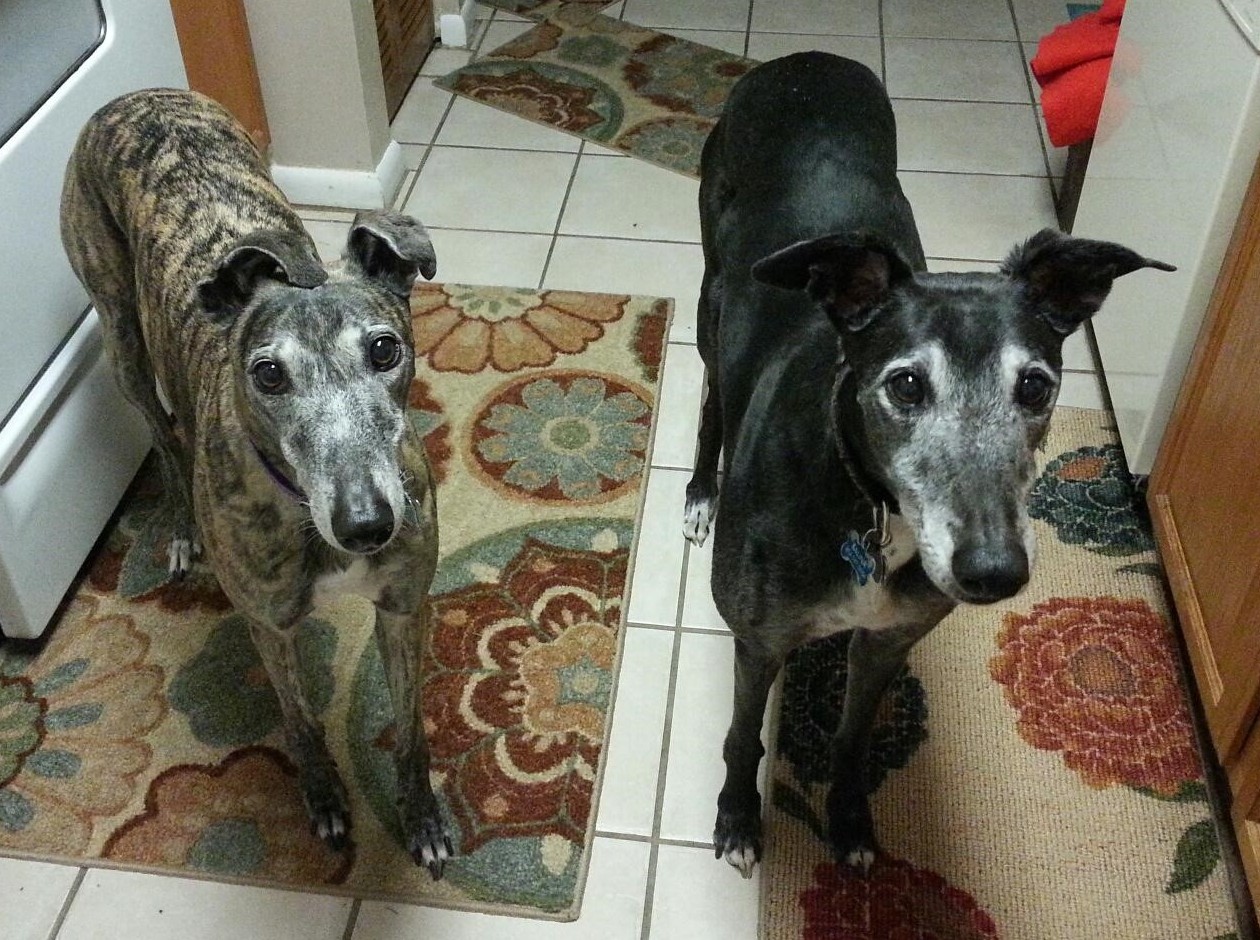
"Must Read" Articles:
Are
Greyhounds and Galgos the same, or are there differences in the
breeds?
You will find the answers here.
What is a Galgo?
The Galgo Español or Spanish Greyhound is an ancient breed and a member of the sighthound family.
Despite being called a “greyhound”. The Spanish Galgo is not closely related to the English/Irish Greyhound, the lineage of the two breeds being different. In ancient times the galgo was a prized possession, but currently they have become disposable “hunting tools”.
Galgos are smooth-or rough-coated in a variety of colors;
their coat may be one solid color, bindle or two colors in combination. They are similar in appearance to racing
greyhounds but are distinctly different in their conformation. Galgos have a leaner musculature, more
characteristic of an endurance runner than the “sprinter’s” build of the
English/Irish racing greyhound. They are
long, lean, elegant dogs; in fact, it’s hard to describe them without
over-using the word “long”; they have long backs, long tails and long
streamlined heads with almond shaped eyes.
colors in combination. They are similar in appearance to racing
greyhounds but are distinctly different in their conformation. Galgos have a leaner musculature, more
characteristic of an endurance runner than the “sprinter’s” build of the
English/Irish racing greyhound. They are
long, lean, elegant dogs; in fact, it’s hard to describe them without
over-using the word “long”; they have long backs, long tails and long
streamlined heads with almond shaped eyes.
Galgos have a similar nature to greyhounds; many are calm, usually quiet, gentle and laid back. They are however curious and many are jumpers – baby gates and 4’ fences are not an obstacle for them. Described as a 40-mph couch-potatoes, content to sleep their day away, they are happy with a couple of short walks per day but can also make excellent jogging companions.
Many galgos live with cats and other small animals without problem, while others, given careful introductions, can be trained to do so once they have learned the appropriate boundaries.
Galgos are widely used by hunters in the rural areas of Spain for both hunting and hare coursing with betting. They are considered disposable and when the short hunting season ends each year in February, tens of thousands are abandoned or brutally killed by their owners to whom they are no longer of use.
Some galgos are put into perreras (killing stations) where their lives are to be ended. The majority are abandoned or escapees living rough and scavenging to survive until caught by rescuers such as Galgos del Sol. My Gunner was thrown away with his siblings at 3 days old and luckily was rescued by Galgos del Sol. They helped raise the puppies with a foster mum galgo and hand bottle feeding.
If you are interested in adopting a Galgo, please feel free
to contact us via email carolbellavia77@gmail.com
and we can put you in touch with a rescue. Please take a few moments to go to
Galgos del Sol’s website to see the work they do and all available dogs...galgosdelsol.org
About Greyhounds
Greyhounds
are affectionate, charming, and friendly by nature ... they
thrive on attention and love their humans and make great pets. Not
all Greyhounds are alike. They share many traits, but like you and
me, they are individuals and each one has their own personality.
Sometimes when you first adopt your Greyhound, he may be shy and
quiet, but his personality will come out as he gets comfortable and gets to know you. They can be aloof, like a cat, sleep like
a cat, and the next moment they get this burst of energy and begin
running from room to room like they are on a race track for 5 minutes
... then they stop, and go lay down! (A tip for you –
if your home is all tile or laminate, you may want to invest in
runners and secure them to the tile or laminate so your Grey doesn't
slip on the surface and injure himself).
friendly by nature ... they
thrive on attention and love their humans and make great pets. Not
all Greyhounds are alike. They share many traits, but like you and
me, they are individuals and each one has their own personality.
Sometimes when you first adopt your Greyhound, he may be shy and
quiet, but his personality will come out as he gets comfortable and gets to know you. They can be aloof, like a cat, sleep like
a cat, and the next moment they get this burst of energy and begin
running from room to room like they are on a race track for 5 minutes
... then they stop, and go lay down! (A tip for you –
if your home is all tile or laminate, you may want to invest in
runners and secure them to the tile or laminate so your Grey doesn't
slip on the surface and injure himself).
Greyhounds or Greyhound like dogs can be found as far back in history as 500 B.C. Greyhounds evolved to hunt in the Middle East and were revered by ancient Egyptians and highly regarded by other cultures in the Middle East. They became established in the United States when the early settlers in the Midwest discovered that Greyhounds were fast enough to take care of jackrabbits that were eating their crops.
Greyhounds, with proper care, can live from 12-14 years. Boys average weight can be between 65 and 80 pounds, girls are slightly smaller, they can be between 55 pounds to 67 pounds. Greyhounds recognize other Greyhounds – it is amazing, you can be walking your Greyhound and they will be aloof when they see other dogs, but the moment they see another Greyhound, it is like they are long lost buddies and will drag you to meet the other Greyhound!
Greyhounds have been kennel broken, not housebroken, but they learn quickly to go outside and relieve themselves. You need to walk them frequently at first and develop a routine ... they will get it. Patience is very important – think about it, they have gone from living in a kennel their entire lives with other Greyhounds and now, they find themselves alone in a strange place with humans hovering over them and expecting them to be like a regular grown dog. They have not been touched while asleep, fed on a strict schedule, no one touches your bowl while you are eating, you are not asked if you have to go out. Let your new Greyhound learn about you, being in your home and give him some space and a break. Greyhounds are sensitive ... yelling at them will not achieve anything but having them fear you.
 Greyhounds
are sight hounds, they detect movement immediately with instant
reaction times, they have incredible speed and agility to close
in on something. This ability allows them to go from a dead
stop to 40 miles per hour in three strides.
Greyhounds
are sight hounds, they detect movement immediately with instant
reaction times, they have incredible speed and agility to close
in on something. This ability allows them to go from a dead
stop to 40 miles per hour in three strides.
They, unlike other dogs, are bred to chase down prey with little or no guidance from a human. When they are fixed on going after a squirrel or rabbit, they will not pay attention to your calls to have them return to you ... add in the speed, and it could turn ugly very quickly. You need to keep your wits about you when you are walking your Greyhound and keep a good hold on their leash.
To keep your Greyhound safe, you MUST make a commitment to NEVER let him off leash, except in an enclosed fenced yard ... electric fences do not qualify. Greyhounds will blast through the electronic fence and never feel anything. With that said, many people like to bring their dogs to dog parks (I personally do not feel a dog park is a safe place for a Greyhound). Greyhounds have very thin skin. What would be a simple scratch to a Labrador Retriever may be a nasty tear, requiring several stitches, for your Greyhound. If another dog at the dog park begins rough play you can be in for a very expensive vet bill or, depending on where they have been bitten, it can be something much worse. If you are with a group of Greyhounds for a play date, the “turnout” muzzle you received when you adopted your dog should be used so when they play hard they don't injure each other by nipping.
Like all dogs, some regular exercise is required. Walking your Greyhound a few times a day should be sufficient. First thing in the morning, lunchtime and after dinner and maybe one more quick trip before bed should be good. Please see the information on Heat Exhaustion for walking your Grey here in Florida.
Greyhounds have little body fat, this makes them sensitive to heat, cold, and rain. If it is cold outside and you and your Greyhound are outside for more than a short time, they should wear a coat. If you are cold, your Greyhound is cold. We have links for some great Greyhound sweaters, coats and more on our website. If it is raining hard, a raincoat is also good to keep your Greyhound dry.
Life
here in the Villages is very different for your Greyhound, it is
different from anywhere else! Your Greyhound, prior to you adopting
him, was in a kennel with many other Greyhounds. He went from the
kennel crate to the race track, fed and watered, let out to relieve
himself, then returned to his kennel crate. He has never seen traffic,
lots of people, music in a town square, and NEVER has
encountered golf carts whizzing by as you are walking him. You need
to take things slow and introduce him to the Villages world little
by little. I wouldn’t recommend taking your Greyhound to the square
until you know your dog’s fears and he is comfortable with you and
walking. You need to know how your dog is going to react to little
dogs who may get in his face (there are more little dogs here in
the Villages than big dogs), how he will react to little children
running up to him, etc. We try to take our Greyhounds to the town
squares during the fall, winter and spring at least once a month
... plan on joining us. If your dog is shy or nervous for the
first trip, he will be very comfortable with other Greyhounds and
we can always surround him with other Greyhounds to ease his fears.
If you want to learn more about Greyhounds, I recommend you read "Retired Racing Greyhounds For Dummies", by Lee Livingood.
Home About Greyhounds Events Our Hounds In Memory Of Veterinarians Links Contact Us

Website Designed and Maintained by LaDebug Computers
